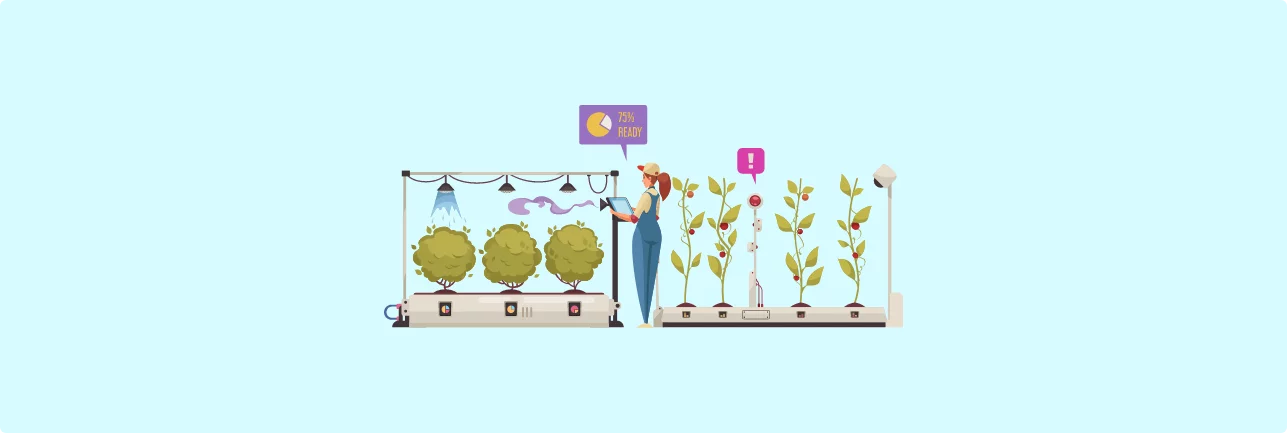How IOT has modernized the entire agricultural industry- A life changer for the whole planet
Posted By - Pony

Posted On - September 19, 2022

According to predictions, there will be more than 9 billion people in 2050. Therefore, the need for food will take dizzying new heights irrespective of untoward facts like deteriorating soil, extreme weather, drying lands, etc.
IoT and its applications may be a lifesaver for the entire humanity. It’s considered a boon when it comes to protecting Earth from the scarcity of preparing crops and feeding humanity in the upcoming days. It’s showing a ray of hope with its increased demand. Millions of dollars have been spent on deploying IoT machines across the globe.
Agricultural industries have already spectated several effective technological transformations in the last few decades. The result is multifaceted- technology driven and more modernized. Farmers now have better control over raising livestock and growing crops with various gadgets. In turn, it becomes more predictable while improving its efficiency.
Also, the ongoing consumer demand has contributed to the expanding proliferation of smart farming technologies. Today, we’ll discuss how IoT has interspersed its efficacy in agriculture and how people are reaping its benefits.
Let’s dive right in.
What is a smart farm?
Smart farms are managed by using smart technologies while adopting modern forms of communication. Smart farmers may use various technologies-
- Dedicated software to diagnose animal and plant disease, followed by treating the same.
- Sensors to control the humidity of water, moisture, and soil.
- Tracking and managing the locations using satellite and GPS.
- Operating the smart farm with robotics and automated tools. It helps to improve the crops’ quality and quantity.
What is smart farming?
Smart farming entails the usage of smart technologies like sensors, automated machines, drones, actuators, security cameras, etc., to control and operate agricultural lands and cattle. The motto is to increase both agricultural goods’ quality and quantity. Consequently, energy usage and cost also play a pivotal role in uplifting the entire process of smart farming.
Building up smart agriculture using IoT
The Internet of things has fueled the growth of agricultural and food production with its branches, including advanced analytics and big data. When it comes to IoT, the parent terms automation, sensing, and analytics all come one after another. The most common applications are-
- Smart farming drones, vehicles, autonomous robots
- Sensor-based systems for controlling and monitoring the crops.
- Influencing the production of crops using IoT
- Visualization, data analytics, and management systems
How’s IoT shaping the entire agricultural landscape?
With burgeoning technology, the internet of things is now the bedrock of making things more mellifluous in terms of transformation and scalability.
- Tons of important data and analysis can improve the crop’s growth progress, soil quality, and cattle’s health. This data can also help to assess the business state, equipment efficiency, and staff performance.
- With big data comes the better control over the internal process. Farmers can foresee the production output while planning for better product distribution. For example, if farmers know the amount of crop harvesting, they can hatch up on the next steps accordingly.
- As farmers can see the crop growth anomalies, they can mitigate the risks of losing the yield.
- Using smart devices can automate multiple processes like fertilizing, irrigation, and pest control.
- Farmers can now gain better control over the production process, while maintaining high standards of crop quality. The growth capacity will also be increased.
Benefits of IoT in agriculture
The Internet of things has changed the entire landscape of agriculture. Everything has made the pathway smooth, from excelled efficiency to reduced manual labor. In turn, it can resonate better with the technology.
1. Increased food production
As we stated earlier, the increased number of populations may create an untoward situation. However, technology has shouldered the load by enabling IoT-based hydroponic systems and greenhouses. It can feed people with veggies and fresh fruits. With smart closed agricultural systems, food can grow anywhere. With this increased food production, food demand can be easily met.
2. Enhanced efficiency
In this fast-paced world, feeding humanity isn’t an easy task with the growing issues like economic breakdown, socio-political wars, and declining quality of nature. However, the internet of things allows farmers to control and monitor their products in real-time. Now, they can get the insights first to make informed decisions.
3. Clean process
IoT has enabled the reduction of the usage of fertilizers and pesticides. As it scales down the use of pesticides and fertilizer, it opens the path to make the farming greener. The final output can be more organic compared to traditional agricultural methods.
4. Increased agility
Enhanced agility has made the entire process less cumbersome. All the courtesy goes to real-time monitoring and prediction systems. Farmers now can respond to any significant changes. It may include air quality, humidity, weather, etc. Accordingly, they can make decisions that would be effective in the long term.
5. Better product quality
With data-driven agriculture, the output is now excellent. With drone monitoring, farm mapping, and sensors, farmers now have better control over situations. Also, the connected systems help them to recreate the best conditions for the best production.
Wrapping it up
Irrespective of the market condition, people need to eat and drink to maintain a balanced life. On that note, the internet of things has echoed the same thing the experts want to cater to the demands of agricultural needs. Yes, it’s a priority based on the given circumstances. Therefore, it can be said IoT has a promising feature that will drive the force of sustainability, scalability, and efficiency.












